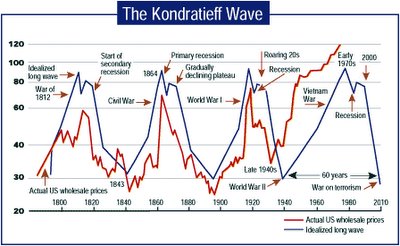 If you're into investment cycles and charts, the Kondratieff Wave is one to examine. Basically the boom and bust cycle had a 60 year span. Here is a link to more detail http://www.kwaves.com/kond_overview.htm Credit the picture above from this link.
If you're into investment cycles and charts, the Kondratieff Wave is one to examine. Basically the boom and bust cycle had a 60 year span. Here is a link to more detail http://www.kwaves.com/kond_overview.htm Credit the picture above from this link.The cycle this time around is a little long in the tooth. There is a reason for this and I believe as do some others, that it has to do with the increase in the length of the average persons life span.It use to be about 60 years now we are up to about 75 years.
Each generation has a group of elders that can draw from past mistakes. We are at a point right now, that the follies of the 1920's and 1930's are not part of our "group memory" any more. Most people from that era would be at least 100 years old now. Now when you quote some historical aspect a cause of the last depression, you hear the phrase,"Its different this time."
People today think that the interest only no money down mortgage is something new. Well it isn't. They were written right up to the collapse in 1929. The banks soon realized that it was like the neighbor taking out your daughter for a "test drive" before he married her. The responsibility factor was missing.
Cycles are usually displayed as circles that would follow through phases and complete back where they started. I think that this is not a true analogy of what is happening here. If you start with a spiral going out from the center, this more correctly displays "history repeating itself." It s not quite the same, things have changed somewhat.
People are consuming more and more, and with that, comes the creation of more debt. It is this debt that will be marked to market. Mr. Kondratieff's theory suggests that all of this debt will disappear and the money supply will contract accordingly (drastically in this case).
I don't think that people fully realize how money disappears. Take Lucent Technologies a few years back. It sold for $80 per share and went down to $2. Somebody owned it the whole way down.
What really scares me today, is the people with savings and retirement funds, they have been funding this whole thing. The market will always go up (believe that and I'll tell you another). The trouble is, a majority of the owners of wealth, are going to want to get out of the market pretty soon and they are at the head of the line-- the baby boomer's.The baby boomer's think that this will be a relaxing walk into retirement. More likely its going to be one hell of a panic. If Mr Kondratieff is right, there will be a drastic contraction of the money supply because of the debt marked to market, and because of this, commodities should fall in price.
My question is this. If the world population has increased 4 times in the last 60 years and most of these governments have been printing money at a very vigorous rate, can gold and silver still be considered commodities? I think that they reside outside the realm of consumables.
3 comments:
Jim,
what re your thoughts on the fact that the relationship between the lines has changed.
During previous times, the red line-prices led the blue line. However, this time around, the blue line is leading. This must have major implications to the theory that I don't quite understand yet, but was hoping that you had it figured out.
also, what do wholesale prices have to do with the economy going through a depression or recession? I don't quite get the chart and its meaning to our times.
thanks in advance for your time.
Hi Anon
I probably should have explained the graph a bit. The blue line represents the idealized Kondratieff curve, showing four complete cycles. The red line is actual wholesale price data plotted for the last 200 years.
I would guess that wholesale prices were used, because the data was available over a long span of time that was dependable and accurate.
His theory was created in two steps. First plot the statistical data, then highlight major historical depressions and draw conclusions.
His cycle appears to be about 60 years. The question arises that the last one should have been about 1990, what happened?
What some of us suggest, is that the cycle had to do with remembering the last crash. In the past hardly anyone survived to age 65. Thus we have the future repeating past mistakes. The group memory of the last crash is gone. What was done then will be done again by a new group of players.
What we are looking at in today's world is a life span of 75 to 85 years which suggests that the next crash has been postponed only because our group memory of the last crash lived longer.
What I and others are suggesting, is that the wave is valid, Kondratieff had no idea that the frequency revolved around life span length.
With the markets now unwinding, the Kondratieff wave is moving downwards in earnest. I think people the wave theory will be on many people's minds very soon.
http://www.longwavepress.com/Baby_Boomers_Generation_X_SCv1a.pdf
Post a Comment